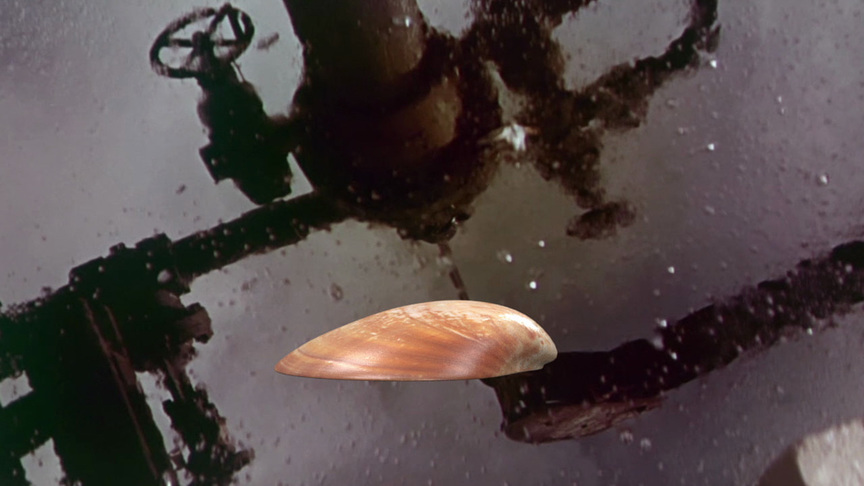-
From Current Issue
-
- Editor’s Letter Fire in the Heart
- Reviews I Gusti Ayu Kadek Murniasih
- Reviews 11th Seoul Mediacity Biennale: “One Escape at a Time”
- Dispatch Networked China
- One on One Monira Al Qadiri on Yukio Mishima
- Essays The rise of independent art spaces in pandemic-era Shanghai
- Features Tuan Andrew Nguyen
- Table of Contents
- Web Exclusives
- Archive
- Subscribe

R
E
V N
E
X
T
Installation view of ZHENG MAHLER’s Bubalus bubalis 16–40,000Hz, 2021, audio, sculpture, Chladni plate, video, book, dimensions variable, at “Liquid Ground,” Para Site, Hong Kong, 2021. Photo by Samson Cheung Choi Sang. Courtesy the artist.
We are living in the Anthropocene. As a species, we have surpassed others in transforming the ecosystems and biochemistry of Earth, doing what had once only been done by severe forces of nature. For anthropologist Anna Tsing, the Anthropocene began with modern capitalism, which has devastated our landscapes and spoiled the relationships we have with other species. In The Mushroom at the End of the World (2015), she proposes decentralizing the human perspective and capitalistic notions of progress in favor of alternative, pluralistic, and nonhuman views—like that of the matsutake mushroom—to explore a more collaborative and sustainable way of life.
“Liquid Ground,” curated by Alvin Li and Junyuan Feng, put forward a similar proposal for a multispecies, collaborative, and decentralized effort to salvage our ecosystems, using the capital-driven land reclamation proposed for Hong Kong’s Lantau Island as its critical port of entry. A vast plywood island pointedly sat at the center of Para Site and prevented a panoramic view of the show, provoking one to search for alternative ways of seeing. Hips and elbows were mildly grazed as visitors encircled its curvature, either to explore the installations around its parameters or to seek an opening to access the vibrations within.
The rumbling came from the ultrasonic frequencies in artist duo Zheng Mahler’s Bubalus bubalis 16–40,000Hz (2021), an ethnographic research-based installation on the wild water buffaloes on Lantau Island. Rippling water on Chladni plates visualize the sound waves audible to bovids, and invite one to eavesdrop on the nonhuman conversations that unfold across the wetlands, which are seen in an accompanying video. Completing the installation with a water buffalo-guided travelogue that introduces Lantau’s obscure animal trails, Zheng Mahler attentively extend their agency to their bovid neighbors, divulging the island’s enduring human-bovid dependencies and how these animals have cultivated the landscape.
Also based on Lantau, Zheng Bo’s Drawing Life (Xin Chou, Grain Rain) (2021) comprises 15 pencil drawings of the flora around his house. Placed below eye level on a wood board, the images foreground the nonhuman with thoughtfulness and attention, capturing an accurate likeness through each stroke of graphite against paper, and thereby evoking a degree of intimacy and individuality more characteristic of portraiture than still life. In centering water buffaloes and plants, Zheng Mahler and Zheng recall Tsing’s proposition with intense clarity.
Multiple other works in the show were stationed on the floor, spatially reinforcing the exhibition’s critique on the gluttonous extraction of resources from the earth for profit- and power-driven aspirations, while attuning the viewers’ sensitivity to the ground. Among these works was Shell Revolution (2018) by Ho Rui An, an animation on the evolution of the Royal Dutch Petroleum Company and its contributions to the deterioration of our air, water, and soil.
Less direct in its commentary but with a similar placement was Lee Kai Chung’s Sea-sand Home (2021). The installation includes a heap of sand onto which an aerial view of Lantau is projected, a publication compiling Lee’s research on the mainland Chinese origins of the sand used in Lantau’s ongoing coastal expansion, and three salt-and-metal towers in the process of corrosion. Poetically intertwined, the work’s elements at once reflect the displacement of sand and the disturbance of ecologies, create a vivid metaphor of the total integration of the Special Administrative Region with the mainland, and suggest nature’s post-human revival.
“Liquid Ground” was a polyphony. It brought together varying voices in a chorus that articulated ambitions for a collective, multispecies commons. While it may have taken a moment to listen to and absorb each perspective, the exhibition as a unit portrayed the land as a living presence with which we have many different relationships. In the far corner of the exhibition, Future Host and Heidi Lau’s sculpture and video collaboration, Worlding Hands (2021), reenacts the Chinese creation myth of the goddess Nüwa molding humanity from mud. As she digs her fingers deep into the ground and melds her body into the earth, a visceral connection with the land is potently revived, reminding us that the earth is our source of life.
Nicole M. Nepomuceno is ArtAsiaPacific’s assistant editor.
“Liquid Ground” was on view at Para Site, Hong Kong, from August 14 to November 14, 2021.
To read more of ArtAsiaPacific’s articles, visit our Digital Library.










